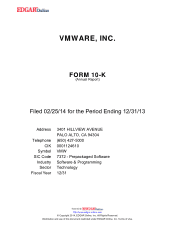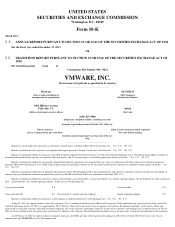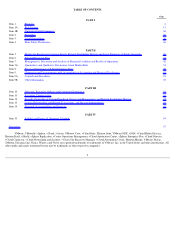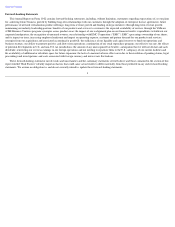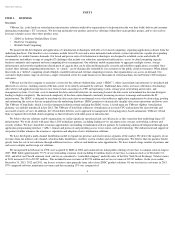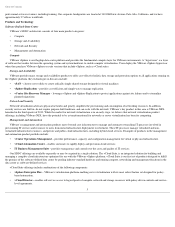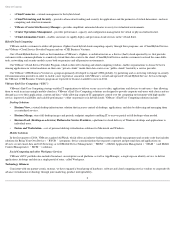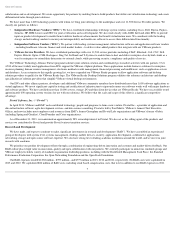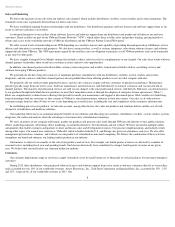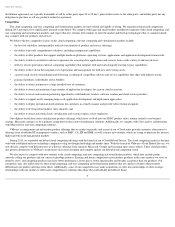VMware 2013 Annual Report Download - page 11
Download and view the complete annual report
Please find page 11 of the 2013 VMware annual report below. You can navigate through the pages in the report by either clicking on the pages listed below, or by using the keyword search tool below to find specific information within the annual report.
Table of Contents
distribution agreements are typically terminable at will by either party upon 30 to 90 days' prior written notice to the other party, and neither party has any
obligation to purchase or sell any products under the agreement.
Competition
The cloud computing, end-user computing and virtualization markets are inter-related and rapidly evolving. We experienced increased competition
during 2013 and expect it to significantly intensify in the future. We compete with large and small vendors in different segments of the cloud computing, end-
user computing and virtualization markets, and expect that new entrants will continue to enter the market and develop technologies that, if commercialized,
may compete with our products and services.
We believe the key competitive factors in the cloud computing, end-user computing and virtualization markets include:
Our vSphere-based data center virtualization product offerings, which have evolved into our SDDC product suites, remain central to our business
strategy. Microsoft continues to be a primary competitor for data center virtualization solutions. Additionally, we compete with Citrix and its collaborations
with Microsoft for end-user computing solutions.
VMware’s management and automation product offerings that we market separately and as part of our vCloud suites provide customers alternatives to
offerings from established IT management vendors, such as BMC, CA, HP and IBM, as well as many new entrants, which are trying to penetrate the nascent,
higher growth cloud management markets.
During 2013, we expanded our hybrid cloud computing offerings with the launch of our vCloud Hybrid Service. The cloud computing market is dynamic
with both established and new technology companies vying for thought leadership and market share. With the launch of VMware vCloud Hybrid Service, we
now directly compete with Infrastructure-as-a-Service offerings from Amazon, Microsoft, Google and emerging open source efforts. These cloud providers
also present alternatives to VMware's on-premises data center footprint and compete against our hybrid cloud computing vision.
We also expect to compete with new entrants to the cloud computing, end-user computing and virtualization markets, which may include parties
currently selling our products and our current technology partners. Existing and future competitors may introduce products in the same markets we serve or
intend to serve, and competing products may have better performance, lower prices, better functionality and broader acceptance than our products. Our
competitors may also add features to their cloud computing, end-user computing and virtualization products that are similar to features that presently
differentiate our product offerings from theirs. Additionally, some of our competitors may make acquisitions or enter into partnerships or other strategic
relationships with one another to offer more comprehensive solutions than those they individually had offered. Some
9
•
the level of reliability, interoperability and new functionality of product and service offerings;
•
the ability to provide comprehensive solutions, including management capabilities;
•
the ability to offer products that support multiple hardware platforms, operating systems, applications and application development frameworks;
• the ability to deliver an intuitive end-user experience for accessing data, applications and services from a wide variety of end-
user devices;
• delivery of next-generation end-
user computing capabilities that integrate with and work alongside existing, legacy capabilities;
•
the ability to drive down the marginal cost of operations and management for both new and existing assets;
•
a proven track record of formulating and delivering a roadmap of compelling software and service capabilities that align with industry trends;
•
pricing of products, individually and in bundles;
•
the ability to attract and preserve a large installed base of customers;
•
the ability to attract and maintain a large number of application developers for a given cloud ecosystem;
•
the ability to create and maintain partnering opportunities with hardware vendors, software vendors and cloud service providers;
• the ability to support newly emerging large-
scale application development and deployment approaches;
•
the ability to deploy operational cloud solutions for customers in a timely manner and provide robust technical support;
•
the ability to develop robust indirect sales channels; and
•
the ability to attract and retain cloud, virtualization and systems experts as key employees.

